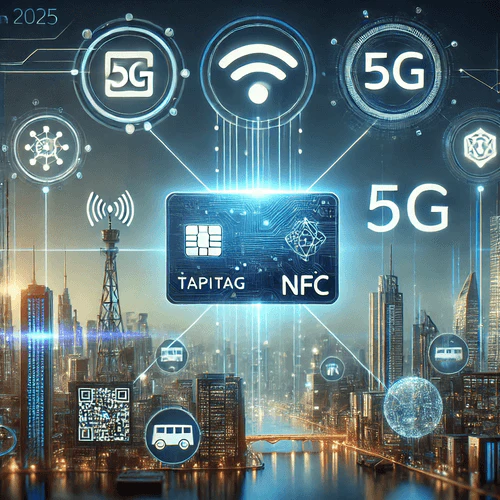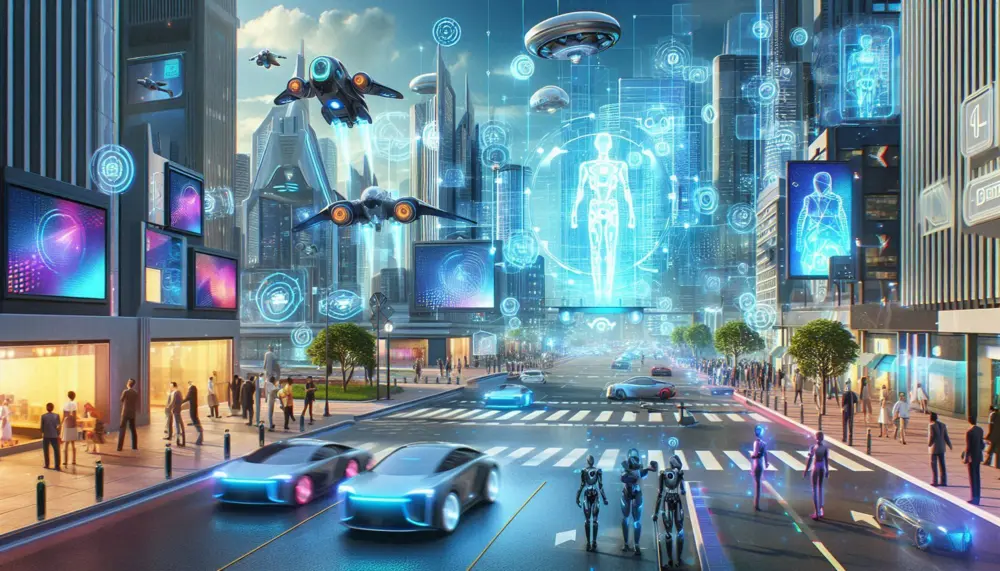Emerging Technologies: The rapid advancement of technology is revolutionizing industries, creating new opportunities, and reshaping how we live. As we look toward 2025, certain emerging technologies will profoundly impact various sectors, from healthcare to space exploration. Here are some of the most promising trends that will shape the future. IT professionals, in particular, will need to adapt to new trends, learn new skills, and keep pace with technological advancements. Here are the top 25 emerging technologies to watch in 2025.
1. Generative AI: Revolutionizing Content Creation

Generative AI is set to be one of the most dominant technologies in 2025. This technology allows for the creation of highly sophisticated and human-like content, including Text, images, audio, and simulations. With advancements in generative models like GPTs and multimodal systems, AI is transforming industries by enhancing productivity, automating design, and improving customer engagement. Organizations will continue to leverage generative AI to innovate faster and offer personalized services at scale.
2. Quantum Computing: Solving Complex Problems
Quantum computing uses the principles of quantum mechanics to process information at exponentially faster speeds than classical computers. This emerging technology can potentially revolutionize industries by solving problems currently intractable for traditional computing systems. Applications are already being explored in fields like cryptography, where quantum computing could break secure codes, and drug discovery, where it can simulate molecular structures with high precision.
Read more: Top Best 20 Jobs Trending in 2025 in the World for the Future of Work
3. 5G Expansion: Powering Next-Generation Technologies

The rollout of 5G networks is one of the most anticipated technological advancements. With significantly faster data speeds, broader coverage, and more stable connections, 5G will enable technologies like IoT, augmented reality (AR), and autonomous vehicles to thrive. This ultra-fast, low-latency network will support real-time communication and massive data processing, driving innovations across various industries.
4. Virtual Reality (VR) 2.0: Enhancing Immersive Experiences
Virtual Reality (VR) technology is evolving to offer even more immersive and realistic experiences. With improved display resolutions, motion tracking, and interactive elements, VR is becoming increasingly important in the gaming, training, and healthcare sectors. New VR systems are becoming more user-friendly, with lighter headsets and longer battery life, allowing for broader adoption and integration into daily life.
5. Augmented Reality (AR): Transforming Industries
Augmented Reality (AR) is expected to be a game-changer in 2025. With advancements in AR glasses and mobile devices, this technology will create more interactive, immersive experiences for users. AR can transform industries like retail, education, and real estate by allowing users to visualize products, learn in new ways, and interact with the physical world in an entirely new manner.
6. IoT in Smart Cities: Improving Urban Life
The Internet of Things (IoT) makes cities smarter by connecting various sensors and devices that collect and analyze data to optimize resource management. IoT technology is crucial for making cities more efficient and sustainable, from monitoring traffic and public transport to managing energy use and public safety. As urban areas grow, IoT will play a key role in improving the quality of life for city residents.
7. Biotechnology in Agriculture: Addressing Global Food Challenges
Biotechnology is revolutionizing agriculture by enabling the development of genetically modified crops with enhanced traits, such as increased resistance to pests, better nutritional profiles, and higher yields. Techniques like CRISPR gene editing allow crops to withstand environmental stresses like drought and salinity, helping secure the food supply and adapt to climate change challenges.
8. Autonomous Vehicles: The Future of Transportation

Autonomous vehicles, which rely on AI, sensors, and machine learning, are moving closer to mainstream adoption. While fully autonomous cars are still under development, progress has been made in integrating autonomous systems into public transportation and freight logistics. These vehicles have the potential to reduce accidents, ease traffic congestion, and decrease emissions.
9. Blockchain Beyond Crypto: Securing Digital Transactions
Initially created for cryptocurrencies, blockchain technology is finding new applications across various industries. Its ability to provide transparency, enhance security, and reduce fraud makes it valuable for use cases such as tracking goods in supply chains, ensuring secure medical records, and facilitating tamper-proof voting systems.
10. Edge Computing: Real-Time Data Processing
Edge computing refers to processing data closer to the source of its generation rather than relying on a centralized cloud infrastructure. This technology is essential for real-time applications like autonomous vehicles and industrial IoT, where low latency and quick decision-making are critical. By reducing reliance on the cloud, edge computing allows for faster, more efficient data processing in remote or decentralized locations.
11. Personalized Medicine: Tailored Healthcare Solutions
Personalized medicine transforms healthcare using genetic, environmental, and lifestyle data to create tailored treatments. Advances in genomics allow doctors to provide targeted therapies, particularly in oncology, where specific genetic mutations in cancer cells can be addressed with precision. This approach promises better patient outcomes with fewer side effects.
12. Neuromorphic Computing: Mimicking the Human Brain
Neuromorphic computing is an innovative field that involves designing computer chips inspired by the human brain’s neural networks. These chips process information in ways traditional computers cannot, significantly improving energy efficiency and computational power. Neuromorphic computing is ideal for real-time learning, pattern recognition, and sensory data processing applications.
Read more: Top Best 20 Jobs Trending in 2025 in the World for the Future of Work
13. Green Energy Technologies: Advancing Sustainability

Green energy technologies are rapidly advancing, focusing on improving the efficiency and reducing the costs of renewable energy sources such as solar, wind, and bioenergy. Innovations in photovoltaic cells, wind turbines, and biofuels pave the way for a cleaner, more sustainable energy future. These technologies are essential for reducing carbon emissions and meeting global sustainability goals.
As we approach 2025, these emerging technologies are poised to reshape industries and societies worldwide. Staying informed and adaptable will be critical for professionals to thrive in the rapidly changing technological landscape. Keeping an eye on these trends will ensure you’re prepared for the future and equipped with the right skills to navigate the evolving world of technology.
14. Wearable Health Monitors: Revolutionizing Personal Health
Wearable health monitors have become more advanced, continuously tracking vital health metrics such as heart rate, blood pressure, and blood sugar levels. These devices connect to smartphones and use AI to provide real-time insights into users’ health, offering early warnings of potential issues. With a growing focus on preventive healthcare, this trend drives personalized health insights and empowers individuals to take control of their wellness.
15. Extended Reality (XR) for Training: Immersive Learning Experiences
Extended Reality (XR), which includes virtual reality (VR), augmented reality (AR), and mixed reality (MR), is transforming training across industries. XR is used for immersive, risk-free simulations in healthcare, aviation, and manufacturing sectors. These technologies improve learning outcomes by replicating real-life scenarios, enhancing engagement, and reducing training costs, offering a more effective way to acquire hands-on experience.
16. Voice-Activated Technology: Enhancing User Interaction
Voice-activated technology has significantly advanced, allowing devices to understand and process natural human speech more accurately. This trend is widely used in smart speakers, home automation, and customer service bots, making interacting with technology using voice commands easier. With further integration into vehicles and public spaces, voice technology enhances accessibility and convenience for users, paving the way for a hands-free future.
17. Space Tourism: A New Frontier in Adventure
Space tourism is moving closer to becoming a reality thanks to companies like SpaceX and Blue Origin. Space tourism offers everything from suborbital flights to planned orbital missions, making space travel accessible to a wider audience. This emerging industry opens new avenues for adventure and drives innovation in aerospace technology and space exploration research.
18. Synthetic Media: Redefining Content Creation
Synthetic media, which involves content generated entirely by AI, is one of the most intriguing technological developments. This includes deepfakes, virtual influencers, and automated video production. While it raises ethical questions, synthetic media offers vast entertainment, education, and media creation possibilities. It enables the creation of increasingly indistinguishable content from that made by humans, transforming how we produce and consume digital media.
19. Advanced Robotics: Automating Complex Tasks
Advancements in robotics are creating machines capable of performing complex tasks with little or no human intervention. Robotics is being applied in diverse industries, from manufacturing, where robots perform precision tasks, to healthcare, where surgical robots assist doctors. As AI and machine learning continue to improve, robots are becoming more adaptable and capable, enhancing efficiency and productivity across various sectors.
20. AI in Cybersecurity: Strengthening Digital Defense
As cyber threats become more sophisticated, AI is critical in enhancing cybersecurity. AI systems can process vast amounts of data to detect abnormal patterns, predict potential threats, and implement real-time defenses. This technology is crucial in safeguarding sensitive data and preventing cyberattacks, providing organizations with the tools to protect their digital assets.
21. Digital Twins: Optimizing Operations and Maintenance
Digital twins are virtual replicas of physical objects or systems, allowing for real-time monitoring, simulation, and predictive maintenance. This technology is extensively used in the manufacturing, urban planning, and automotive industries to optimize operations and reduce downtime. Companies can test scenarios and predict potential failures by creating a digital version of physical assets, improving efficiency, and reducing costs.
22. Sustainable Technology: Driving Eco-Friendly Innovation
Sustainability is becoming a significant priority across industries, leading to developing technologies that minimize environmental impact. Sustainable technologies focus on reducing energy consumption, lowering carbon emissions, and promoting circular economy practices. From renewable energy sources like solar and wind to AI-powered solutions optimizing resource use, sustainable technology is reshaping industries with a focus on ecological balance and long-term sustainability.
23. Telemedicine: Transforming Healthcare Delivery
Telemedicine, which enables patients to consult doctors remotely via digital platforms, has become a vital healthcare tool, especially during the COVID-19 pandemic. As the technology matures, telemedicine is expanding to offer a broader range of services, making healthcare more accessible and convenient. This shift toward remote care is revolutionizing the healthcare industry, allowing patients to receive care without physical visits.
24. Nanotechnology: Unlocking New Possibilities at the Molecular Level
Nanotechnology, manipulating matter at the atomic and molecular levels, has vast applications across various fields. This technology is used to develop more effective drug delivery systems, create more robust and lighter materials, and improve electronics, such as more minor, more powerful chips. As nanotechnology continues to evolve, it holds the potential to revolutionize everything from medicine to manufacturing.
25. AI TRiSM (AI Trust, Risk, and Security Management): Ensuring Ethical AI Use
AI TRiSM (Trust, Risk, and Security Management) is emerging as a critical framework for ensuring AI technologies’ ethical and responsible use. This approach embeds trust, transparency, and security throughout the AI lifecycle. By assessing and mitigating risks, detecting biases, and ensuring privacy safeguards, AI TRiSM fosters stakeholder trust and promotes ethical AI adoption. This trend is crucial as AI becomes more integrated into industry decision-making processes, ensuring these technologies are used responsibly and safely.
Conclusion: Staying Ahead of the Curve
The technological landscape is evolving rapidly, and staying informed about the latest innovations is vital to remaining competitive in the future job market. The technologies listed above are not just trends; they are the foundation for the next generation of industries and services. As we move into 2025 and beyond, embracing these technologies will drive progress and open new opportunities for businesses and individuals.














